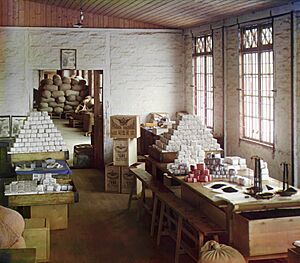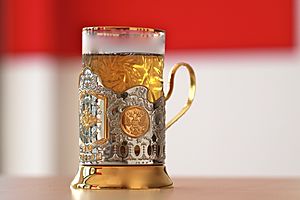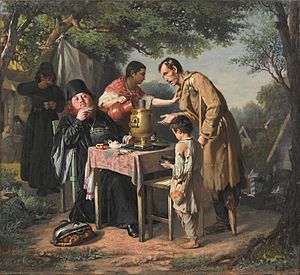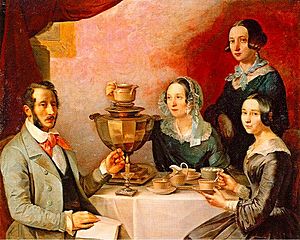Russian tea culture facts for kids

Tea is a very important part of Russian culture. Because Russia has a cold climate, tea is like the country's national drink. It's one of the most popular drinks there and is strongly linked to Russian traditions. Russian tea is usually brewed strong. It can be served sweet, hot, or even cold. People traditionally drink it in the afternoon. But now, it's enjoyed all day, especially after meals with dessert. A special part of Russian tea culture is the samovar, which is used to brew the tea.
Contents
History of Tea in Russia
Tea became popular in Russia starting in 1638. That year, a ruler from Mongolia gave about 65–70 kilograms (143–154 pounds) of tea to Tsar Michael I. Some say that in 1636, a Russian envoy named Vassili Starkov was given 250 pounds of tea as a gift for the Tsar. Starkov first thought the dried leaves were useless, but the ruler insisted. This is how tea was first brought to Russia.
In 1679, Russia made a deal with China for regular tea supplies. Tea would travel from China to Russia by camel caravans. In return, Russia would send furs. The Chinese ambassador in Moscow also gave several chests of tea to Tsar Alexis I. However, this trade route was very difficult. This made tea extremely expensive. So, only the royal family and very rich people in Russia could afford it.
The Tea Road Opens
In 1689, the Treaty of Nerchinsk was signed. This treaty officially recognized Russia's control over Siberia. It also created the Tea Road. This was a special path that traders used to bring tea between Russia and China.
Between 1689 and 1727, Russia sent more caravans to China for tea. But only government traders were allowed to do this. In 1706, Peter the Great even made it illegal for other merchants to trade in Beijing.
Tea Becomes More Affordable
In 1786, Catherine the Great brought back regular tea imports. By the time she passed away in 1796, Russia was importing over 3 million pounds of tea. This tea came by camel caravan as loose tea and tea bricks. This large amount of tea helped lower its price a lot. Soon, middle and lower-class Russians could also afford to drink tea.
The busiest year for the tea trade through Kyakhta was 1824. The peak year for tea caravans was 1860. After that, the caravans started to decline. This happened when the first part of the Trans-Siberian Railway was finished in 1880. Faster train service cut the time it took for tea to reach Russia from 16 months to just seven weeks.
Because Chinese tea became less common in the mid-19th century, Russia started importing more tea from Odessa and London. By 1905, horse-drawn tea transport had stopped. By 1925, caravans were no longer the only way to transport tea. In 2002, Russia imported about 162,000 metric tons of tea.
Tea Companies and Local Production
By the late 19th century, Wissotzky Tea became the biggest tea company in the Russian Empire. By the early 20th century, Wissotzky was the largest tea maker in the world.

By the end of the 18th century, tea prices had gone down quite a bit. The first local tea plant was set up in the Nikitsk botanical gardens in 1814. The first large tea farm was started in 1885. The tea industry really grew after World War I and even more after World War II. However, by the mid-1990s, tea production in Russia almost stopped. Today, the main area in Russia for growing tea is near Sochi.
Types of Russian Tea
Traditionally, black tea is the most common type of tea in Russia. However, green tea is becoming more and more popular.
A traditional Russian tea is known as Russian Caravan. It got this name because it was originally brought from China by camel caravans. The journey was very long, often taking 16 to 18 months. During this trip, the tea got its special smoky flavor from the campfires of the caravan. Today, this tea often gets its smoky taste after being processed. It can also be a type of keemun or a black or oolong tea from southern China or Taiwan, with a hint of smoky Lapsang souchong.
How Russians Brew Tea
A special way of making tea in Russia is a two-step process. First, a strong tea concentrate called zavarka (Russian: заварка) is made. A small teapot is used to brew enough dry tea for several people. Then, each person pours some of this strong tea into their cup. They then mix it with hot water. This way, everyone can make their tea as strong as they like. People often add sugar, lemon, honey, or jam to their tea.
Russian Tea Culture
In Russia, tea is often enjoyed with other treats. Even wealthy people would have it with jam, syrup, cakes, cookies, candies, lemon, and other sweets. This is like the old saying "чай да сахар" (tea and sugar).
The Russian language has some fun phrases about drinking tea. For example, "гонять чаи" means "to chase the teas." This describes drinking tea for a very long time. Another phrase is "побаловаться чайком," which means "to indulge in tea."
Tea became an important part of cultural life for writers in the 1800s. By the mid-19th century, tea was popular among townspeople, merchants, and the middle class. This is shown in plays by Alexander Ostrovsky. Since his time, people have spent more time drinking tea and consumed more of it. Alexander Pushkin showed how tea helped start romantic relationships in his famous work, Eugene Onegin:
- Of single boredom, right away
- They speak–but in a cunning way.
- They call him to their samovar–
- None but Dunya will pour the tea;
- They whisper to her: "Dunya, see!"
- And then produce her sweet guitar.
- O Christ! She then begins to cheep:
- "Come see me in my golden keep!"

During the Soviet era, tea drinking was very common for office workers. Tea brands at that time had nicknames like "the brooms" (Georgian tea) and "the tea with an elephant" (Indian tea). Tea was always a part of kitchen life for smart, educated people in the 1960s and 1970s.
In Russia, tea preparation can be different, but it usually includes lemon and sugar or jam. Tea bags are very popular. But when a teapot is used, people often make a strong brew. Then they pour some into a cup and add hot or boiling water, milk, and sugar.
In the 19th century, Russians would drink their tea with a cube of sugar held between their teeth. This tradition still exists today.
Traditional Russian tea items include the samovar for brewing tea. There are also Lomonosov tea sets with a blue net design and 22 karat gold. And don't forget the traditional Russian tea glass holders.
"Russian Tea" in Other Countries
United States
There is a drink called "Russian Tea" that probably started in America. This drink is very popular in the Southeastern United States. It's traditionally served at social events during Advent and Christmastide (the Christmas season). Recipes are different, but the most common ingredients are loose black tea, orange juice (or orange peel), cinnamon, and cloves. Some recipes use instant tea powder. Other juices like lemon and pineapple are sometimes added. Cream can also be added when serving. A homemade "instant" version, often using Tang, has become a popular gift in recent years.
This drink is served hot and is often enjoyed in the evening or after a meal. However, iced versions are sometimes offered with meals at cafés. Even though it's called "Russian Tea," it likely has no real connection to Russia. Mentions of "Russian Tea" and recipes have been found in American newspapers and cookbooks as early as the 1880s.
Japan
In Japan, the term "Russian tea" means drinking black tea with a spoonful of jam. The jam can be stirred into the cup or placed on the tongue before drinking. Strawberry jam is a common choice, but other jams are used too.
See also
 In Spanish: Cultura rusa del té para niños
In Spanish: Cultura rusa del té para niños




